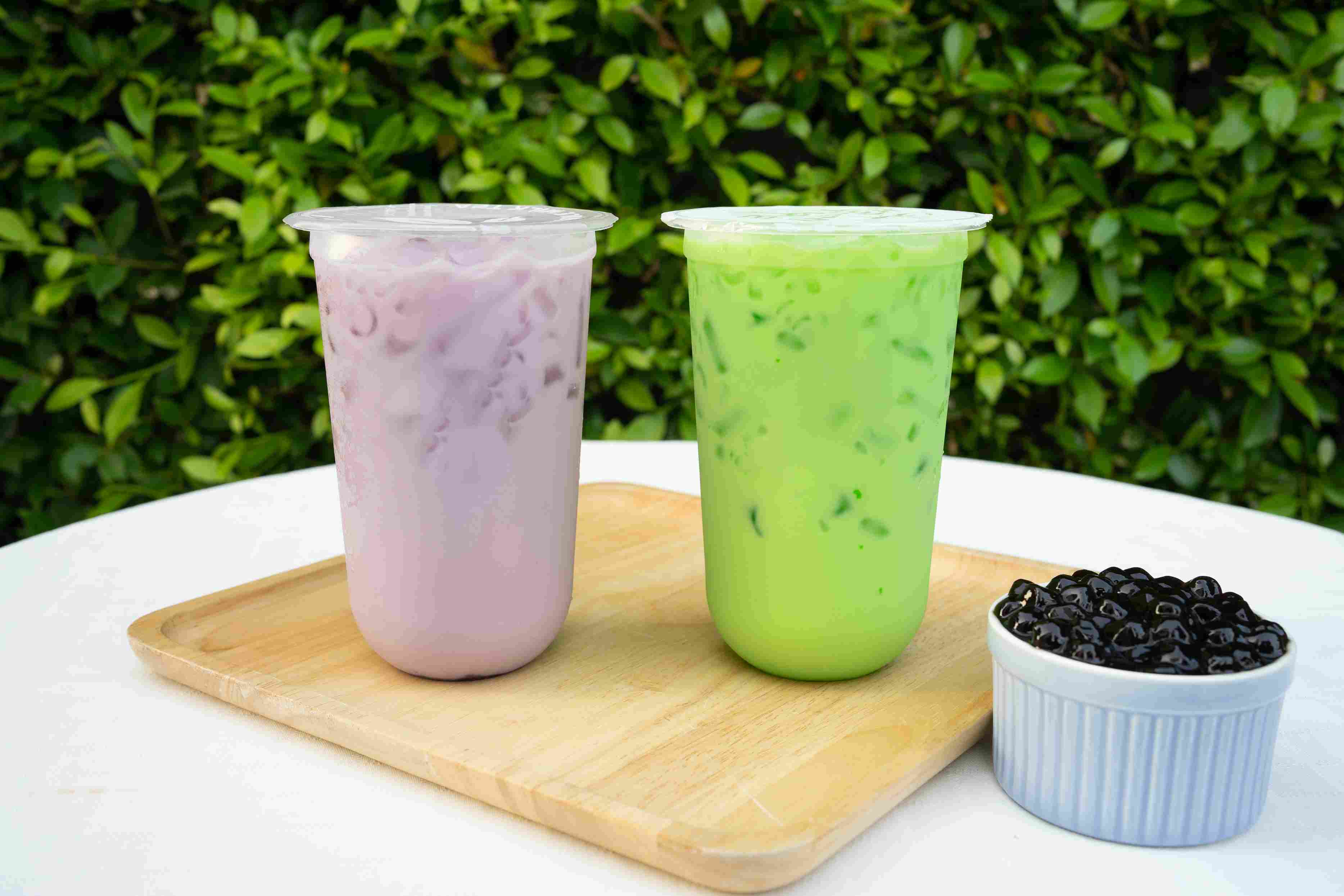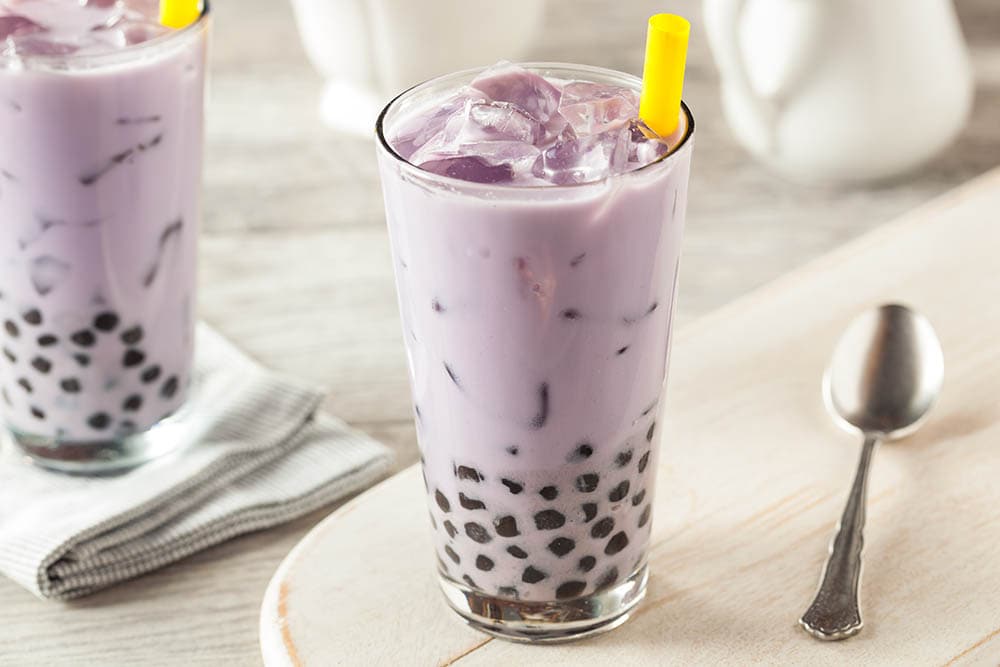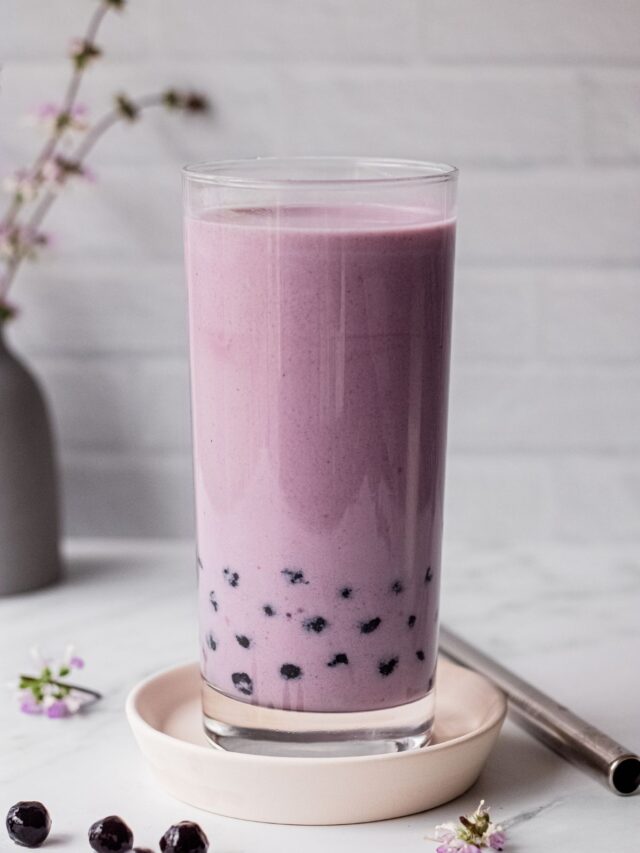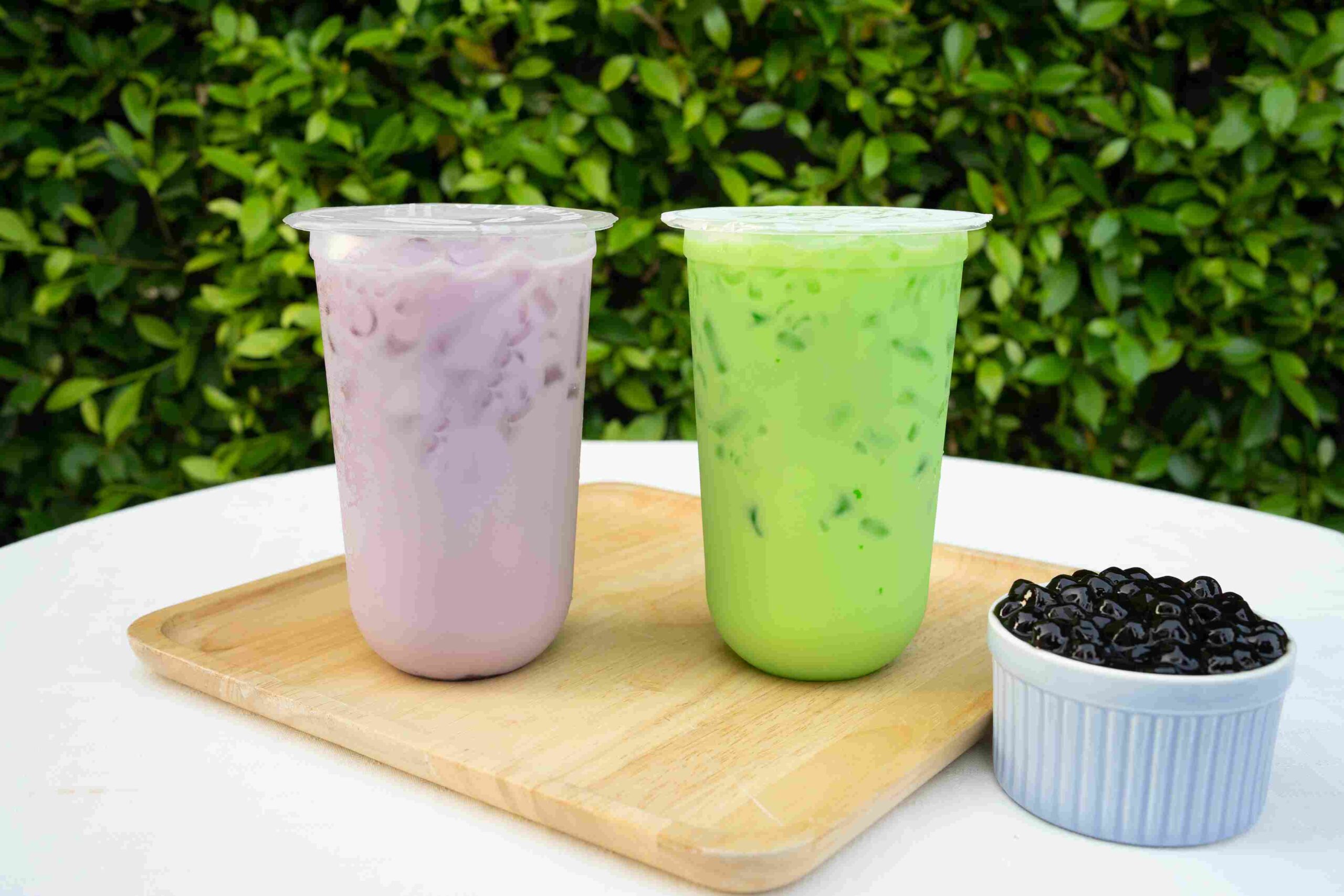Origins and Historical Context of Taro
Mostly from Southeast Asia, starchy root vegetable taro has a long history spanning thousands of years. Its nutty, somewhat sweet taste—which has been highlighted in many Asian cuisines—has made it a mainstay in these areas. Especially, the Māori people of New Zealand were instrumental in distributing taro around the Pacific by means of their customary cuisine. From a basic side dish, taro has evolved over the years into a revered component gladly embraced in dessert recipes, snacks, and drinks both.
Because of phenolic compounds, taro is famously brilliant purple. It is a good ingredient since it is loaded in vital nutrients.
Introduction to Taro Milk Tea
More recently, taro has been included into beverages—especially with the creativity of Taro Milk Tea. Inspired by creative boba tea sellers in Taiwan who aimed to increase their menu and satisfy a variety of client tastes, this delicious beverage came about. Their creamy mixture made from combining taro paste or powder with milk, sugars, and ice became somewhat well-known right away. Taro Milk Tea has become a global palace today, evidence of the imaginative blending of traditional components with contemporary drink culture.
The Special Taste Profile of Taro Milk Tea
Taro has really amazing flavour. Often described as a perfect mix of nutty and gently sweet, taro presents an appealing characteristic unique among other root vegetables. Taro Milk Tea’s velvety feeling from its creamy texture makes every sip a wonderful sensation. Taro’s inherent sweet taste comes through when blended with other ingredients to provide a soothing and decadent drink.
Taro adds a special earthy richness. Its mild sweet undertones counter more strong tastes.
Complementary Ingredients in Taro Milk Tea
A few crucial components are absolutely necessary to improve the taste profile of Taro Milk Tea and help to create the ideal version:
- Milk: Whether dairy or plant-based, the creaminess from the milk complements taro to create delightful, smooth drink.
- Sweeteners: To balance taro’s earthiness, sugar or condensed milk is added, therefore enabling customised sweetness.
- Ice: Perfect for hot days, it’s a cool respite from the warm tastes.
- Tapioca Pearls: Though not required, adding chewy tapioca pearls adds a delightful texture that many people love.
These components used together provide a symphony of tastes and textures, therefore enhancing Taro Milk Tea to a popular drink drunk by many.
Health Advantages of Taro Milk Tea
Nutritional Value of Taro
Not only is taro a great addition to your milk tea, but it also has a lot of nutritional value which makes it a wise choice. Important minerals and vitamins abound in this vivid root, including:
- Dietary fibre aids in digestion and extends feelings of fullness.
- Vitamin C is an antioxidant meant to boost immune system.
- Potassium is absolutely vital for preserving normal blood pressure.
- Important for general metabolic health and generation of energy are iron and magnesium.
Including taro in your diet can be a delightful and nouraging event.
Potential Medical Advantages
Thanks to its unusual ingredients, drinking taro milk tea has several health benefits:
- Taro’s great fibre content helps control blood sugar levels, so possibly reducing surges following meals. For individuals with diabetes especially, this is quite helpful.
- Soluble fibre from taro could help to decrease cholesterol, therefore lessening the risk of heart disease.
- Weight Management: Taro’s capacity to induce satiety helps to reduce bad snacking between meals, so facilitating the adherence to a balanced diet.
- If black tea serves as the base, you also gain from antioxidants meant to fight oxidative stress in the body.
Thus, sip that Taro Milk Tea for the health benefits stored inside as much as for its great taste!
Popular Taro Milk Tea Variations
Bubble Tea with Taro
Bubble tea, sometimes referred to as boba tea, has gone global and taro flavour is leading edge in this movement. The sweet, nutty taste of taro mixed into bubble tea contrasts wonderfully with crunchy tapioca pearls. Imagine yourself: Enjoying a bright afternoon, you are drinking taro bubble tea while pearls burst in your mouth as you savour the creamy smoothness.
- For boba enthusiasts, the traditional taro bubble tea—which combines taro, milk, and sweeteners—is the ultimate delight.
- Some variants call for fresh fruits like mango or strawberry to boost taste and nutrient value.
Taro Milk Tea Desserts
Apart from drinks, taro has established a reputation in the dessert industry as well. Its vivid hue and soothing taste create many interesting opportunities.
- Every scoop of sweet, creamy, and quite popular taro ice cream captures the essence of taro.
- From cakes to cookies, taro pastries—with their soft, fluffy texture and sweet, nutty notes—create an appealing delicacy.
Taro shines in every dessert, demonstrating that it is a flexible element that makes every gastronomic creation joyful rather than only a beverage. The tastes of a taro-flavored dish or a cup of taro bubble tea will definitely warm your heart and fulfil your taste receptors.
The Cultural Value of Taro Milk Tea
Taro in Asian Cooking
Long a staple of Asian cuisine, taro is prized for its distinctive taste and nutritional value. Traditionally, this adaptable root vegetable has been a mainstay of many Southeast Asian recipes. From sweet to savoury, taro is adept in improving the taste sensation.
- Taro is used in everything from classic rice dishes to desserts like taro cake and sweet soups.
- Taro is a beloved food year-round in many Asian countries since it symbolises success and is usually included in celebratory cuisine.
This rich legacy prepared the stage for the creative fusion Taro Milk Tea exhibits.
Taro Milk Tea in Modern Culture
Fast forward to now, Taro Milk Tea has evolved from its roots to become a worldwide sensation mostly shaped by the bubble tea culture starting in Taiwan.
- Sipping Taro Milk Tea has evolved into a social event whereby friends meet in bubble tea stores to savour this mouthwatering drink, therefore creating a cultural touchpoint.
- Instagrammable Appeal: Food bloggers and influencers highlighting the drink’s vivid beauty have made it a sensation on social media thanks to its arresting lavender colour.
Taro Milk Tea highlights how food can promote community and shared experiences worldwide by brilliantly blending new trends with history.
Making Taro Milk Tea at Home
Tools and Ingredients
Making your own Taro Milk Tea at home is a rewarding and enjoyable endeavour! Either fresh taro root or taro powder will help you to make this delicious drink. You will require:
- Components:
- Boba, dried tapioca pearls, have a typical chewy feel.
- Essential for taste is taro paste or powder.
- Milk: Choose from dairy or plant-based substitutes.
- Sweetened condensed milk: Taste will allow you to change the degree of sweetness.
- Brown sugar will help you create a syrup optional for soaking the tapioca pearls.
- Made with brewed tea, green or jasmine tea tastes great.
- Ice: To cool a drink.
- Machinery:
- Pot: For boiling tapioca pearls.
- Blender: To smooth out components.
- Measuring cups and spoons guarantees exact measurements.
Step-by-Step Guide for Preparation
- Get ready the Tapioca Pearls: Usually boiling for 20 to 30 minutes, follow package directions to cook the dried pearls; then, soak them in sugar syrup.
- Making the tea: About five minutes in boiling water, steep your selected tea; then let it cool.
- Mix ingredients: In a blender, toss taro paste or powder, milk, condensed milk, and brewed tea. Blend until seamless.
- Put together the Drink: Add ice and cooked tapioca pearls to a glass. Over the top pour your taro milk mixture.
- Enjoy: Whirl thoroughly and sip with a large straw. Delicious!
You can now enjoy Taro Milk Tea right from your own house’s comfort!
Exploring Taro Milk Tea Globally
Regional Adaptations
Adapting to many cultures and gastronomic tastes around the world, Taro Milk Tea has created waves well beyond its beginnings in Taiwan. Every area gives the popular drink its own touch, therefore expanding its appeal.
- Southeast Asia: Taro milk tea is commonly mixed with strong brew types and local sweets that accentuate its flavours in nations including Thailand and Vietnam.
- USA: Taro milk tea is often presented with chewy boba pearls alongside a variety of toppings, such grass jelly or sago, so creating a wonderful texture.
Having numerous regional modifications not only highlights taro’s adaptability but also represents the cultural narratives underlying every drink.
Fusion Drinks with Taro Milk Tea
Taro Milk Tea is beautiful in its versatility, which results in interesting fusion beverages combining several gastronomic traditions.
- This delicious mix of creamy taro with earthy matcha creates a visually striking and taste-burdling drink.
- Blending taro with thick coconut milk produces a tropical pleasure that reminds one of sunny trips spent by the beach.
Through taro milk tea experimentation, aficionados can discover a universe of flavours that not only provides a delicious pleasure but also a cultural experience wrapped in every drink!
Timeless or Trendy: Taro Milk Tea
Evolution of Taro Milk Tea
Originally developed in Taiwan, creative bubble tea vendors aimed to provide a distinctive drink appealing to a wide range of customers. Its natural sweet taste and creamy consistency set it apart amid the many flavours accessible over time. Not only in Asia but also all around, taro milk tea became well-known fast because of its enchanted purple colour, which came to represent a great tea experience. From classic taro bubble tea to complex flavour combinations, its development has turned this modest beverage into a cherished fixture in cafés all over.
- Taro Milk Tea has added tastes from many civilisations, therefore generating countless combinations and matching opportunities.
- Instagram Sensation: Social media sharing loves it because of its striking colour and pleasing presentation.
Prospects and Innovations Ahead
Exciting developments are just waiting as Taro Milk Tea keeps changing and flourishing in the beverage market.
- Health-conscious options could expect more versions created with less sugar or plant-based milk substitutes as knowledge of nutritional choices rises.
- Combining taro with other modern flavours like matcha or even savoury ingredients would provide customers fresh sensations.
All things considered, Taro Milk Tea is a timeless classic and a hip treat for drinkers everywhere since it wonderfully strikes a mix between history and modernism.


Leave a Reply